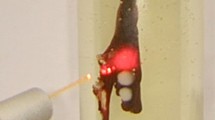Abstract
Despite causing significant thermocoagulative insult, use of the carbon dioxide (CO2) laser is considered gold standard in surgery for early stage larynx carcinoma. Limited attention has been paid to the use of the erbium:yttrium–aluminium-garnet (Er:YAG) laser in laryngeal surgery as a means to reduce thermal tissue injury. The objective of this study is to compare the extent of thermal injury and precision of vocal fold incisions made using microsecond Er:YAG and superpulsed CO2 lasers. In the optics laboratory ex vivo porcine vocal folds were incised using Er:YAG and CO2 lasers. Lateral epithelial and subepithelial thermal damage zones and cutting gap widths were histologically determined. Environmental scanning electron microscopy (ESEM) images were examined for signs of carbonization. Temperature rise during Er:YAG laser incisions was determined using infrared thermography (IRT). In comparison to the CO2 laser, Er:YAG laser incisions showed significantly decreased epithelial (236.44 μm) and subepithelial (72.91 μm) damage zones (p < 0.001). Cutting gaps were significantly narrower for CO2 (878.72 μm) compared to Er:YAG (1090.78 μm; p = 0.027) laser. ESEM revealed intact collagen fibres along Er:YAG laser cutting edges without obvious carbonization, in comparison to diffuse carbonization and tissue melting seen for CO2 laser incisions. IRT demonstrated absolute temperature rise below 70 °C for Er:YAG laser incisions. This study has demonstrated significantly reduced lateral thermal damage zones with wider basal cutting gaps for vocal fold incisions made using Er:YAG laser in comparison to those made using CO2 laser.








Similar content being viewed by others
References
Choy DS (1988) History of lasers in medicine. Thorac Cardiovasc Surg 36(Suppl 2):114–117
Jako GJ (1972) Laser surgery of the vocal cords. An experimental study with carbon dioxide lasers on dogs. Laryngoscope 82:2204–2216
Bredemeier HC (1972) Inventor American Optical Corporation, Southbridge, Mass., assignee. Laser Accessory for Surgical Application. United States of America patent 3659613. June 30, 1969
Steiner W (1993) Results of curative laser microsurgery of laryngeal carcinomas. Am J Otolaryngol 14:116–121
Ambrosch P (2007) The role of laser microsurgery in the treatment of laryngeal cancer. Curr Opin Otolaryngol Head Neck Surg 15:82–88
Higgins KM (2011) What treatment for early-stage glottic carcinoma among adult patients: CO2 endolaryngeal laser excision versus standard fractionated external beam radiation is superior in terms of cost utility? Laryngoscope 121:116–134
Remmelts AJ, Hoebers FJ, Klop WM, Balm AJ, Hamming-Vrieze O, van den Brekel MW (2013) Evaluation of lasersurgery and radiotherapy as treatment modalities in early stage laryngeal carcinoma: tumour outcome and quality of voice. Eur Arch Otorhinolaryngol
Böttcher A, Clauditz TS, Knecht R, et al (2013) A novel tool in laryngeal surgery: preliminary results of the picosecond infrared laser (PIRL). Laryngoscope
Lucioni M, Bertolin A, D’Ascanio L, Rizzotto G (2012) Margin photocoagulation in laser surgery for early glottic cancer: impact on disease local control. Otolaryngol Head Neck Surg 146:600–605
Segelstein DJ, Querry MR (1981) The complex refractive index of water [Ms]: Department of Physics. University of Missouri-Kansas City
Bertrand MF, Semez G, Leforestier E, Muller-Bolla M, Nammour S, Rocca JP (2006) Er:YAG laser cavity preparation and composite resin bonding with a single-component adhesive system: relationship between shear bond strength and microleakage. Lasers Surg Med 38:615–623
Takamori K, Furukawa H, Morikawa Y, Katayama T, Watanabe S (2003) Basic study on vibrations during tooth preparations caused by high-speed drilling and Er:YAG laser irradiation. Lasers Surg Med 32:25–31
Gabric Panduric D, Bago I, Katanec D, Zabkar J, Miletic I, Anic I (2012) Comparison of Er:YAG laser and surgical drill for osteotomy in oral surgery: an experimental study. J Oral Maxillofac Surg 70:2515–2521
Kim SG, Kim EY, Kim YJ, Lee SI (2012) The efficacy and safety of ablative fractional resurfacing using a 2,940-Nm Er:YAG laser for traumatic scars in the early posttraumatic period. Arch Plast Surg 39:232–237
Ossoff RH, Coleman JA, Courey MS, Duncavage JA, Werkhaven JA, Reinisch L (1994) Clinical applications of lasers in otolaryngology–head and neck surgery. Lasers Surg Med 15:217–248
Knappe V, Frank F, Rohde E (2004) Principles of lasers and biophotonic effects. Photomed Laser Surg 22:411–417
Welch AJ, Torres JH, Cheong WF (1989) Laser physics and laser-tissue interaction. Tex Heart Inst J 16:141–149
Jowett N, Wöllmer W, Mlynarek AM et al (2013) Heat generation during ablation of porcine skin with Erbium:YAG laser vs a novel picosecond infrared laser. JAMA Otolaryngol Head Neck Surg 139:828–833
Herdman RC, Charlton A, Hinton AE, Freemont AJ (1993) An in vitro comparison of the Erbium: YAG laser and the carbon dioxide laser in laryngeal surgery. J Laryngol Otol 107:908–911
Hobbs ER, Bailin PL, Wheeland RG, Ratz JL (1987) Superpulsed lasers: minimizing thermal damage with short duration, high irradiance pulses. J Dermatol Surg Oncol 13:955–964
Niemz MH (2007) Laser-tissue interactions : fundamentals and applications. 3rd, enlarged ed. Springer, Berlin
Black JF, Barton JK (2001) Time-domain optical and thermal properties of blood undergoing laser photocoagulation. Laser-tissue interaction XII: photochemical, photothermal, and photomechanical 2:341–354
Black JF, Barton JK (2004) Chemical and structural changes in blood undergoing laser photocoagulation. Photochem Photobiol 80:89–97
Conflict of interest
R. Knecht is a member of the Advisory Boards of Merck Serono, Sanofi Aventis, Boehringer Ingelheim and Bayer Healthcare, Leverkusen.
Author information
Authors and Affiliations
Corresponding author
Additional information
A. Böttcher and N. Jowett contributed equally to this work and share the first authorship.
Rights and permissions
About this article
Cite this article
Böttcher, A., Jowett, N., Kucher, S. et al. Use of a microsecond Er:YAG laser in laryngeal surgery reduces collateral thermal injury in comparison to superpulsed CO2 laser. Eur Arch Otorhinolaryngol 271, 1121–1128 (2014). https://doi.org/10.1007/s00405-013-2761-0
Received:
Accepted:
Published:
Issue Date:
DOI: https://doi.org/10.1007/s00405-013-2761-0




